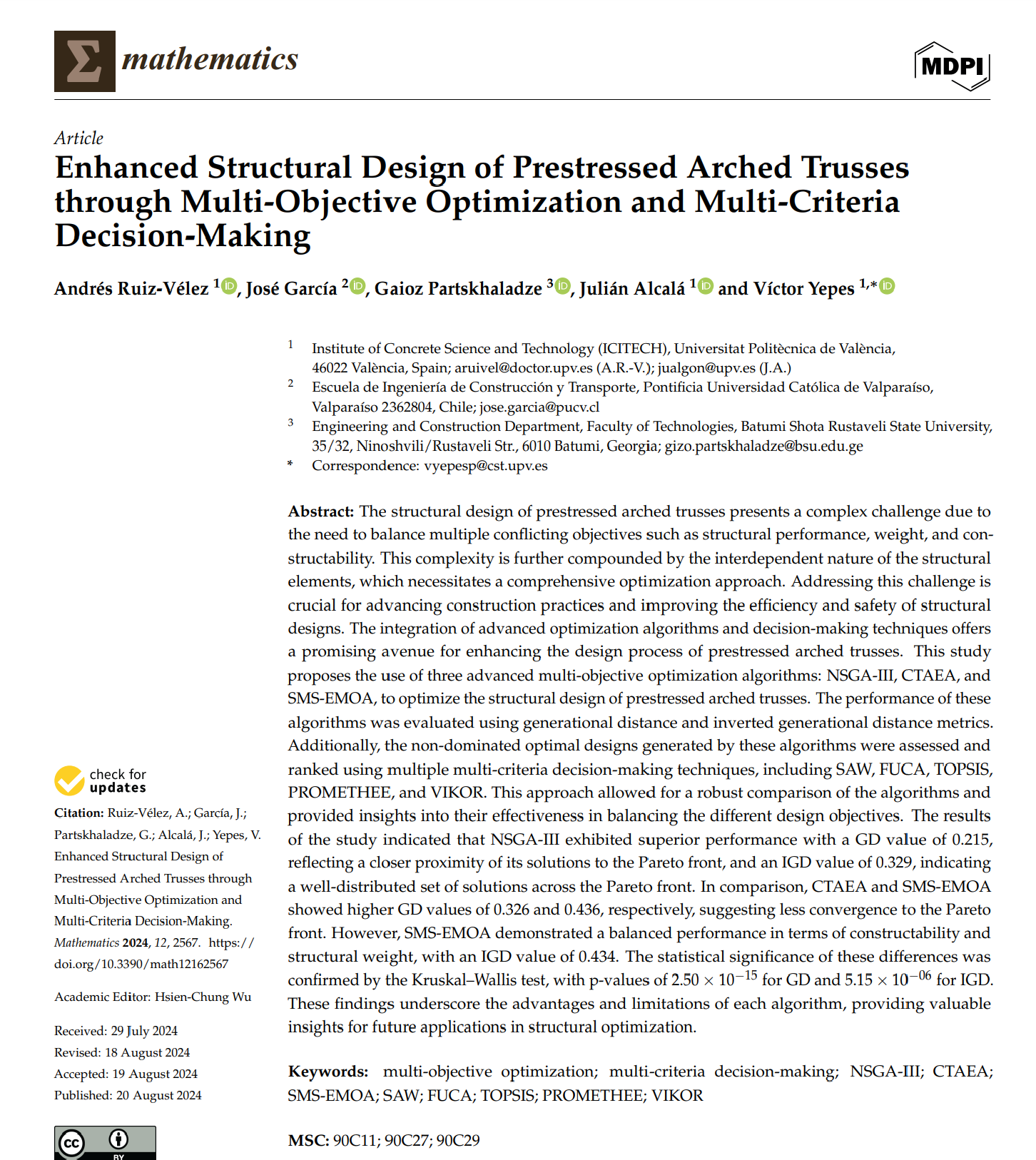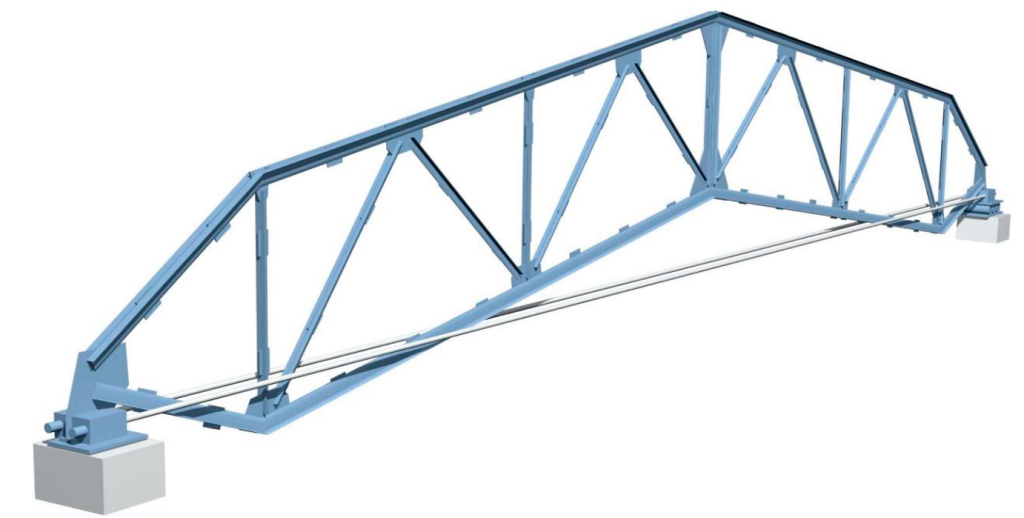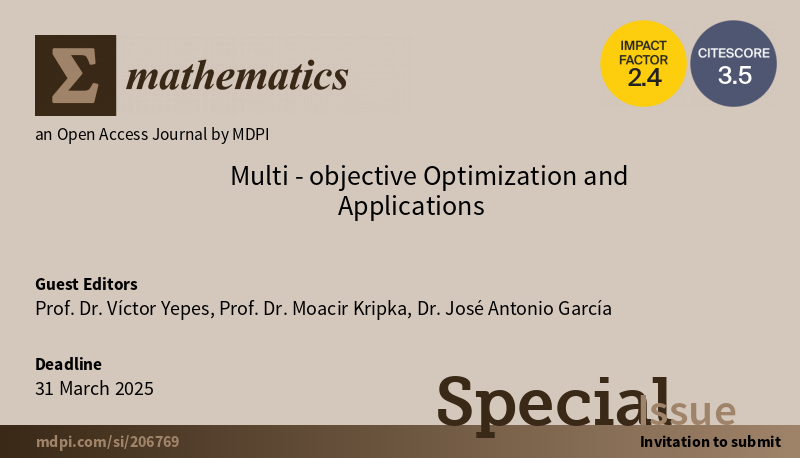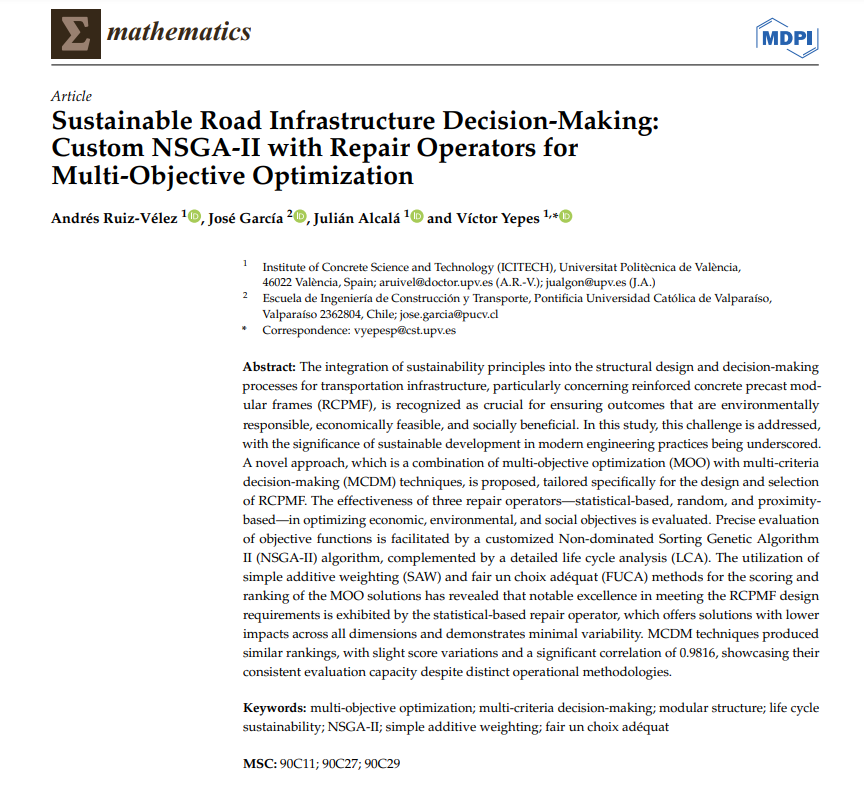 Acaban de publicar nuestro artículo en la revista del primer decil del JCR Mathematics. El artículo presenta un método innovador para optimizar el diseño de puentes mixtos de acero y hormigón mediante un enfoque basado en la teoría de juegos. Este enfoque integra criterios de sostenibilidad económica, ambiental y social con la simplicidad constructiva, abordando de manera simultánea múltiples objetivos que suelen ser conflictivos en proyectos de infraestructura. La principal contribución radica en la aplicación de un método de optimización multiobjetivo (MOO) que permite equilibrar los tres pilares de la sostenibilidad, empleando el Análisis del Ciclo de Vida (LCA) para evaluar el impacto durante todo el ciclo de vida del puente, desde su fabricación hasta su desmantelamiento.
Acaban de publicar nuestro artículo en la revista del primer decil del JCR Mathematics. El artículo presenta un método innovador para optimizar el diseño de puentes mixtos de acero y hormigón mediante un enfoque basado en la teoría de juegos. Este enfoque integra criterios de sostenibilidad económica, ambiental y social con la simplicidad constructiva, abordando de manera simultánea múltiples objetivos que suelen ser conflictivos en proyectos de infraestructura. La principal contribución radica en la aplicación de un método de optimización multiobjetivo (MOO) que permite equilibrar los tres pilares de la sostenibilidad, empleando el Análisis del Ciclo de Vida (LCA) para evaluar el impacto durante todo el ciclo de vida del puente, desde su fabricación hasta su desmantelamiento.
Destaca la implementación de una versión discreta del algoritmo Seno-Coseno (SCA), adaptada específicamente para resolver problemas de diseño estructural. Esta metodología no solo garantiza un diseño eficiente en términos de coste y sostenibilidad, sino que también proporciona una solución práctica que facilita la construcción al reducir los refuerzos en las losas superiores y realizar ajustes geométricos estratégicos. Este enfoque supone un avance en el campo de la ingeniería civil, ya que combina técnicas matemáticas avanzadas con consideraciones prácticas del sector. Este trabajo se enmarca dentro del proyecto de investigación RESILIFE, que dirijo como investigador principal en la Universitat Politècnica de València.
La metodología descrita combina la teoría de juegos con un enfoque cooperativo, en el que los diferentes objetivos (coste, impacto ambiental, impacto social y facilidad constructiva) se representan como «jugadores». Estos jugadores colaboran para encontrar soluciones óptimas dentro del conjunto de soluciones Pareto-óptimas, utilizando el concepto de equilibrio de Nash y reglas de negociación.
El algoritmo Seno-Coseno (SCA) modificado desempeña un papel fundamental en este proceso, ya que permite gestionar variables discretas y restricciones estructurales mediante funciones de transferencia en forma de tangente hiperbólica. Además, se emplea la teoría de la entropía para asignar pesos objetivos, lo que asegura un equilibrio justo entre los criterios y minimiza la subjetividad en la toma de decisiones.
Los resultados muestran que la metodología basada en la teoría de juegos permite reducir el refuerzo de las losas superiores del puente y optimizar el uso de materiales sin comprometer la resistencia estructural. En comparación con un enfoque de optimización monoobjetivo centrado exclusivamente en costes, el método propuesto aumenta los costes en un 8,2 %, pero mejora sustancialmente los impactos ambientales y sociales asociados al diseño.
El estudio revela que, mediante la redistribución del material estructural, es posible mantener la rigidez necesaria en las secciones transversales del puente. En concreto, se observa un aumento en el uso de acero estructural en lugar de acero de refuerzo, lo que simplifica la construcción al reducir la cantidad de barras necesarias y, por ende, el tiempo de instalación y vibrado del hormigón. Este cambio también contribuye a mejorar la calidad del producto final, ya que reduce los errores constructivos y optimiza el tiempo de ejecución.
El análisis demuestra que las soluciones obtenidas mediante métricas de distancia Minkowski (L1, L2 y L∞) proporcionan diseños equilibrados que logran compromisos efectivos entre coste, sostenibilidad y facilidad constructiva. Estas soluciones son comparables a estudios previos en términos de costes, pero ofrecen beneficios adicionales al incluir una evaluación más integral de los impactos sociales y ambientales.
El enfoque presentado abre la puerta a diversas áreas de investigación. Una línea de investigación prometedora es la aplicación de algoritmos híbridos que combinen la teoría de juegos con otras metaheurísticas, como redes neuronales o algoritmos genéticos, para mejorar la exploración y explotación del espacio de soluciones. Esto podría reducir el tiempo de computación y permitir su aplicación a problemas más complejos.
Otra posible dirección de investigación sería ampliar el modelo para incluir criterios como la resiliencia ante desastres naturales o la evaluación de riesgos a largo plazo. También se podría explorar la incorporación de nuevos indicadores sociales, como el impacto en las comunidades locales durante la construcción y operación del puente, lo que ampliaría la evaluación de sostenibilidad. Asimismo, sería interesante aplicar esta metodología a otros tipos de estructuras, como edificios o infraestructuras de transporte masivo, para evaluar su viabilidad y adaptar el enfoque a diferentes contextos.
En definitiva, el artículo proporciona una herramienta muy valiosa para abordar los desafíos de sostenibilidad y eficiencia en el diseño de infraestructuras civiles. La combinación de la teoría de juegos y la optimización multiobjetivo es efectiva para equilibrar criterios complejos y conflictivos, y ofrece soluciones prácticas, sostenibles y viables desde el punto de vista económico y constructivo. Aunque computacionalmente intensivo, este enfoque establece una base sólida para futuras investigaciones y aplicaciones en el campo de la ingeniería civil, lo que permite avanzar en la evaluación integral de la sostenibilidad y en la mejora de los procesos de diseño estructural.
Referencia:
MARTÍNEZ-MUÑOZ, D.; MARTÍ, J.V.; YEPES, V. (2025). Game Theory-Based Multi-Objective Optimization for Enhancing Environmental and Social Life Cycle Assessment in Steel-Concrete Composite Bridges. Mathematics, 13(2):273. DOI:10.3390/math13020273
Os dejo a continuación el artículo completo, pues se ha pbulicado en abierto.






